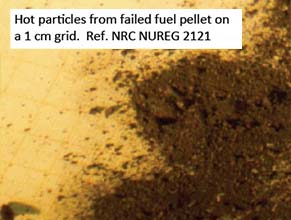http://www.asyura2.com/14/genpatu40/msg/106.html
| Tweet |

Nuclear Engineer: Studies show multiple fuel cores ejected from Fukushima reactors… I thought so too, it was one of my big concerns — Radiation Expert: Hot particles of uranium and plutonium fuels detected nearly 300 miles away (VIDEO)
原子力エンジニア:研究は、多数の燃料炉心が福島の原子炉から排出されたことを示している...私もまたそう考えた、それは私の大きな懸念の一つであった−放射線専門家:ウランとプルトニウム燃料の熱粒子(ホット・パーティクル)が約300マイル(483キロメートル)離れた所で検出された(映像)
Published: August 25th, 2014 at 10:13 am ET By ENENews
公開:2014年8月25日、10:13 ET ENENewsによる

Chris Harris, former licensed Senior Reactor Operator & engineer, Aug 21, 2014 (at 24:00 in): NHK just [broadcasted] that many studies are showing… that multiple cores — parts of it, or some, or even most of it — had been ejected. We thought that too. Once you breach containment, that was one of my big concerns — where did the core go after an explosion like? Whether it be steam or hydrogen explosion or a combination of both… it got ‘sneezed out’ all over the place. It’s totally – it’s a huge mess.
クリス・ハリス、(24分の所で)かつての公認・主任原子炉オペレータ&エンジニア、2014年8月21日:NHKは正に[放送しました]、多くの研究が示しているには...多数の炉心が−その一部、あるいは幾つか、あるいはそれの殆どが−排出されていました。我々もまたそう考えました。一度封じ込めを突破したので、それは私の大きな懸念の一つでした−爆発らしい後に炉心は何処に行ったのでしょうか?それが水蒸気爆発であろうと水素爆発であろうと両方の組み合わせであろうと...あらゆる全ての場所へ「くしゃみ出し」をしました。−巨大な窮地です。
Marco Kaltofen, Nuclear Science and Engineering (pdf), presented at Worcester Polytechnic Institute, March 19, 2014: High Radioactivity Particles in Japanese House Dusts… The Fukushima Dai‐ichi accident released very high activity inhalable dust particles that travelled long distances…
マルコ・カルトーフェン、原子力基礎工学(PDFファイル)、2014年3月19日、ウースター工科大学で発表された:日本のハウスダスト中の高放射性粒子...福島第一の事故は、長距離を移動する非常に高い活性を持ち吸入可能なダスト粒子を放出した...
Airborne dusts can transport radioactive materials as isolated individual particles containing high concentrations of radioisotopes. Alpha and beta emissions related to fission wastes and dispersed fuel particles are hazardous when inhaled or ingested.
空中粉塵は、放射性同位元素を高濃度に含有する単離された個別の粒子として、放射性物質を輸送することができる。吸入したり摂取したとき、核分裂廃棄物や分散された燃料粒子に関連するアルファ(粒子)とベータ(粒子)の排出は有害である。
Radioactively‐contaminated environmental dusts can accumulate in indoor spaces, potentially causing significant radiation exposures to humans via inhalation, dermal contact, and ingestion… a micron‐scaled particle [had] activity greater than 1.0 PBq kg [1 Quadrillion Bq/kg]. The particle was collected from a home in Nagoya, Japan.
放射性に−汚染された環境粉塵は屋内スペースに蓄積し得る、そして吸入、皮膚接触、経口摂取を経由してヒトに潜在的に重大な放射能被ばくを引き起こす... ミクロン−スケールの粒子はキログラム当たり1.0ペタベクレル[1兆ベクレル/ kg]の放射性活性 を[持っていた]。 パーティクルは、日本・名古屋の家庭から収集された。
Nagoya is 460 km from the accident site… It contained both fission products and decay products of 238U… tellurium up to 48.0 %, cesium up to 15.6 %, rubidium up to 1.22 %, polonium up to 1.19 %, dysprosium up to 0.18 %, as well as trace amounts of Sn, lead, nickel, iron, and chromium… 226Ra, 134Cs, and 137Cs, 241Am, and 230Th [were] the most commonly detected gamma photon-emitting isotopes…
名古屋は事故現場から460キロメートルある...それは核分裂生成物とウラン238の崩壊生成物の両方を含んでいた...テルルは最大48.0%、セシウムは最大15.6%、ルビジウムは1.22%、ポロニウムは最大1.19%、ジスプロシウムは最大0.18%、同様に、すず、鉛、ニッケル、鉄、クロム...ラジウム226、セシウム134、およびセシウム137、アメリシウム241、そしてトリウム230は最も一般的に検出されるガンマ放射性同位体[であった]...
about 25 % of dusts sampled [were] autoradiographically positive for hot particles… the majority of these hot particles were 10 um [micrometers] or less in size, meaning that they were potentially inhalable… Radioactively‐hot particles on the respirable size range were routinely detected, with one as far as 460 km [285 miles] from the release site.
サンプリングされた中の約25%はホット・パーティクルとしては放射性写真(オートラジオグラフィー)において陽性[だった] ... これらのホット・パーティクルの大部分は、10[マイクロメートル]か、いやそれ以下のサイズだった、そしてそれらは潜在的に吸入可能であったことを意味していた...放射性−熱粒子(ホット・パーティクル)は、吸入可能なサイズの範囲にあり、放出された原発から460キロメートル[285マイル]も遠くにおいて、ルーチンで(検査すると常に)検出された。
Kaltofen (pdf): Radioisotopes in dusts released by Fukushima Daiichi units [include] Uranium and plutonium fuels and transuranics such as americium and neptunium… individual radioactive particles [in an] Ibaraki dust sample [include] Eu, Y, Zr, Th, Ce, Sr… in 1 to 15 um size range…
カルトーフェン(PDFファイル):粉塵中の放射性同位元素が、福島第一原発によってウランとプルトニウム燃料やアメリシウムやネプツニウムのような超ウラン元素を[含めて]放出された...茨城県のあるダストサンプル[中の]個別の放射性粒子は、ユウロピウム、イットリウム、ジルコニウム、トリウム、セシウム、ストロンチウムを[含む]... サイズは1から15 マイクロメートルの範囲である...
Kaltofen (pdf): The Japanese samples came from as far north as Sapporo in Hokkaido Prefecture and as far south as Tokyo, a range of 780 km. Fifty nine samples of dust from Japan were analyzed… Radioisotopes specific to the Fukushima Daiichi accidents, including Cs134, Cs137, and Co60 were detected in dust samples taken throughout Northern Japan, including areas more than 200 km outside of the accident exclusion zone.
カルトーフェン(PDFファイル):日本のサンプルは、北海道札幌の様に遥か北から、東京の様に遥か780キロ南の範囲から来ました。日本からのダスト59サンプルは分析されました...、セシウム134、セシウム137、そしてコバルト60を含む福島第一事故特有の放射性同位体は、特定の事故除外領域の外側の領域を超える200キロメートル以上を含む、北日本のいたる所で取られたダストサンプルで検出された。
Cs134 was detected at all of the Japanese sites tested… Japanese samples… analyzed in the first month after the accident also contained I131 and Am241… Radioactive dust has become a ubiquitous part of life in northern Japan.
セシウム134は、日本の現場で試験された全てに検出されました...日本のサンプルは...事故.後の最初の月では、ヨウ素131とアメリシウム241も含有していた..放射性粉塵は北日本において至る所にある生活の一部となっている。
Full interview with Harris here
ここでハリスとの完全なインタビュー
▲上へ ★阿修羅♪ > 原発・フッ素40掲示板 次へ 前へ
 スパムメールの中から見つけ出すためにメールのタイトルには必ず「阿修羅さんへ」と記述してください。
スパムメールの中から見つけ出すためにメールのタイトルには必ず「阿修羅さんへ」と記述してください。すべてのページの引用、転載、リンクを許可します。確認メールは不要です。引用元リンクを表示してください。